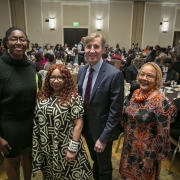Tipping the Scales

ECONOMIC INEQUALITY: ANCIENT ROME
Campbell Grey
Assistant Professor of
Classical Studies
A vast and unbridgeable economic and social gulf separated a wealthy member of Rome's senatorial aristocracy, who resided at Rome for the parts of the year that suited him before fleeing to his seaside villa on the Bay of Naples during the summer months, from the small farmer renting a portion of one of his many estates, who might in addition undertake periodic waged labor and, perhaps, farm his own small holding in pursuit of sufficient produce to satisfy his family's subsistence needs. As much as 90 percent of the population of the Roman world might be categorized as the "have-nots," as against the fabulously wealthy elites whose written works and physical monuments dominate modern perceptions of that world.
However, this immense inequality was, in part, mitigated by two phenomena. First, embedded within Roman society was an ethos of patronage, a mutually binding, reciprocal relationship between individuals of unequal status. Indeed, textual evidence attests such relationships even between the senator and tenant farmer mentioned above. Second, Roman aristocrats acknowledged the close connection between wealth and social standing, on the one hand, and responsibility to the community, on the other. Public beneficence, in the form of building projects, distributions of grain and other foodstuffs, the provision and endowment of public religious festivals, even the payment of a community's collective tax burden, was part and parcel of a wealthy Roman's self-representation and self-perception.
The Roman world was undeniably characterized by economic gulfs every bit as vast as the greatest that exist today. It is reasonable to ask how widespread the phenomena emphasized here were in reality. Nevertheless, for some of the disadvantaged, at least, economic inequality was in some small measure mitigated by practices of giving and beneficence that were ingrained in the culture of Roman society's wealthiest members.
THE PERFECT STORM
Julia Lynch
Associate Professor of Political Science
A visitor from Mars arriving in the U.S. tomorrow might surmise that income inequality has always been a central issue in our polity. In his 2012 State of the Union address President Obama called income inequality "the defining issue of our time," and the Senate responded by convening hearings on the subject. News coverage of inequality is abundant, and our Martian visitor would recognize that "the 1 percent" and "the 99 percent" are widely understood terms to describe the stratification produced by our economy.
Yet while the gap in earnings and wealth between the nation's richest people and average earners has been growing at a rapid clip since the 1980s, the intense attention to inequality in American political discourse is of very recent vintage. President Obama's State of the Union message was the first in the history of the presidency to explicitly mention the problem of income inequality (though Theodore Roosevelt did speak of "social inequality" in his 1901 address to Congress); the Senate hearings are unprecedented; and mentions of income inequality in U.S. print media were three times higher in October of 2011 than they had been just a year previously.
If income inequality has been growing for so long, why is it only now that Americans are making a political issue of it? One explanation is that most Americans simply don't worry that much about inequality. Sociologist Seymour Martin Lipset has argued that America's distinctive value system—which prizes personal liberty at the expense of either collective endeavor or equality of results, and as a result leads us to accept wide income inequalities rather than contesting them politically—has such deep historical roots as to be nearly immutable. Indeed, our national narratives and myths surrounding income and wealth, from Horatio Alger to Bill Gates and Steve Jobs, would seem to support this view. But we can't explain a variable (the political acceptability of inequality) with a constant (American culture)—so we need to look elsewhere for an explanation of why inequality is suddenly a hot political topic.
Another explanation is the rise of the Occupy movement. One scholar found that from October 2010 to September 2011, the word "inequality" regularly occurred in about 400 articles per month in U.S. newspapers. But in October 2011, after the Occupy protests began, the number jumped to over 1,200. The use of "greed" and "richest one percent" rose even more dramatically. The Occupy movement, by raising awareness of an issue and giving us language with which to discuss it, might be responsible for this shift in public discourse.
But while the Occupy movement has without a doubt influenced the debate—perhaps most importantly by making it harder for Republicans to tar political critiques of unbridled capitalism as "class warfare"—the emergence of the movement is more likely a result of the rising salience of the issue of income inequality, not its sole cause.
Income inequality has become more salient because in the economic context of 2011, the steadily eroding wages of middle-income Americans finally became unbearable. The credit crunch and housing crisis reduced Americans' ability to finance consumption through debt, and layoffs reminded many Americans that earnings sufficient to allow for some saving for a rainy day were really a must. At the same time, the bank bailout and the continuing revelations of malfeasance in the mortgage industry have given finance—the perceived home of many of America's top earners—a bad name. The combination of rising grievances, a visible set of "perpetrators," the very effective political framing of the issue by the Occupy movement and the political opening presented by a Democratic president with weak approval ratings and little to lose, created the perfect climate for the emergence of inequality as a new political issue.
WHAT HAPPENED TO ECONOMIC INEQUALITY IN THE GREAT RECESSION?
Dirk Krueger
Professor of Economics, Director of Graduate
Studies
Scholars studying economic inequality in the early 1970s concluded that this area of research was about as exciting as watching the grass in your backyard grow. For a long time, not much had happened. But starting in the second half of the '70s, economic inequality increased massively along many dimensions, a trend that continued, albeit at a slower pace, in the 1990s and the early part of the last decade. Then, the most severe economic downturn since World War II—referred to among economists as the "Great Recession"—hit the U.S., and the world. Although the Great Recession has been dated by the National Bureau of Economic Research as lasting from December 2007 to June 2009, and thus is now officially over, unemployment remains high at 8.3 percent and economic activity has recovered little relative to its long-run trend.
But what has happened to economic inequality in the Great Recession, and how does it compare to previous economic downturns and to the long-run trend in inequality? This is a complex question, not the least because the answer depends on how inequality is measured (earnings, income and consumption inequality) and compared to whom (households at the top, middle or bottom of the distribution). There is little doubt that household earnings inequality has risen sharply in the recession, continuing a trend of rising inequality in income derived from labor that started some 30 years ago. During the Great Recession most of this increase is attributable to rising inequality at the bottom of the earnings distribution (as measured by the 50/20 ratio, the ratio between median household earnings and earnings at the 20th percentile of the distribution). Earnings inequality at the top (measured by the 95/50 ratio) in contrast rose only modestly during the Great Recession. This development is typical of previous economic downturns, but much more pronounced in magnitude. It happened against the backdrop of a long-run rise in earnings inequality that was driven in substantial part by a widening of earnings differences between top and median earnings households.
But most economists think of earnings as a means to an end and envision lifetime economic well-being as determined by consumption and leisure. Even though current disposable income might also only be an imperfect proxy for lifetime consumption and leisure possibilities, it gives a more accurate picture of at least the current ability of households to consume and save. This picture differs significantly from that of earnings. Disposable income inequality displays the same long-run increasing trend, especially at the top of the distribution. However, during the Great Recession, and in contrast to earnings, disposable income did not become significantly more unequally distributed, neither at the top, and perhaps more surprisingly (in light of the earnings inequality trends), nor at the bottom of the distribution. The 50/20 ratio for disposable household income in 2010 and 2011 is roughly at the same value as in the early 2000s. Public social insurance payments, especially unemployment benefits, play a prominent role in explaining this divergence between earnings and disposable income inequality. Consistent with disposable income inequality, inequality in consumption expenditures has remained fairly steady through the Great Recession.
The recent trends in economic inequality are multi-faceted. However, even those that take comfort in the fact that disposable income inequality has not changed much during the Great Recession should be reminded of two facts: (a) inequality in disposable income is significantly larger now than it was 30 years ago, and (b) during the Great Recession median income levels fell, and therefore those at the bottom 20 percent of the distribution might not have seen a fall in their relative incomes but still a fall in their absolute incomes.





